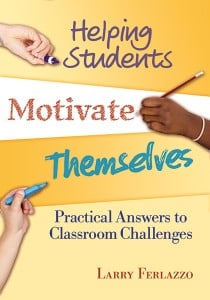Check-out the sequel to this book, titled Self-Driven Learning: Teaching Strategies for Student Motivation.
Look for the sequel, “Self-Driven Learning: Teaching Strategies for Student Motivation,” in March, 2013!
You can now order the book. Just go to the book’s page on their website. The cost is $29.95.
You can also order it on Amazon.
(You can read the book’s introduction here)
You can read an excerpt from the first chapter here
Here’s the entire chapter from the book on qualities of a good lesson
Transcript Of My Ed Week Chat On Motivation Online
First Chapter of My Book, Hand-Outs & Links Are Now Online For Free
“Finishing the School Year Strong” is the title of another excerpt in Education Week/Teacher.
Recording Now Available Of “Helping Students Motivate Themselves” Interview
Nice Review Of My Book, “Helping Students Motivate Themselves”
Uh Oh, Harvard Goal Study Is An “Urban Legend”
Here’s My Chapter On Elements Of A Successful Lesson, Along With Student Hand-Outs THEY Use To Teach
Great Student Hand-Out On Learning & The Brain
Article On Learning & The Brain That’s Perfect For Tenth, Eleventh, & Twelfth Graders
Supporting School-Wide Social Emotional Learning
Michael Jordan Story On Goal-Setting
I thought readers might be interested in seeing the cover, reading a description, and reviewing the Table of Contents (still in the process of being slightly revised) of my upcoming book, Helping Students Motivate Themselves: Practical Answers To Classroom Challenges.
The book will be officially published by Eye On Education on April 30th (though it might actually be in-stock prior to that date), and I will be links to how to order the book and to excerpts that will be published in various publications prior to that date.
Here’s a short description from the publisher:
Give your students the tools they need to motivate themselves with tips from award-winning educator Larry Ferlazzo. A comprehensive outline of common classroom challenges, this book presents research-based and immediately applicable steps and lesson plans for all middle and high school teachers looking to help their students motivate themselves. With coverage of brain-based learning, classroom management, and using technology, these strategies can be easily incorporated into any curriculum.
Learn to implement solutions to the following challenges:
-How do I motivate students?
-How do I help students see the importance of personal responsibility?
-How do I deal with a student who is being disruptive in class?
-How do I regain control of an out-of-control class?
-And more!
Blogger and educator Larry Ferlazzo has worked to combine literacy development with short and rigorous classroom lessons on topics such as self-control, personal responsibility, brain growth, and perseverance. He uses many “on-the-spot” interventions designed to engage students and connect with their personal interests.
Use these practical, research-based ideas to help your students become intrinsically motivated to learn!
CLASSROOM CULTURE
How do you motivate students?
How Can I Help Students See That It Is Important To Take Personal Responsibility And Not Blame Others for Their Mistakes?
How do you deal with a student who is being disruptive in class?
How Do You Regain Control Of An Out-Of-Control Class?
How Do You Help Students Look At Problems As Opportunities, And Not As Reasons To Just Feel Frustrated?
What Are Some Ways I Can Get The Beginning Of The Year Off To A Good Start?
What can I do to help keep my students – and me – focused at the end of the school year?
CLASSROOM INSTRUCTION
What are the best things I can do to maximize the chances of a lesson being successful?
How Can You Best Use A Few Minutes Of “Leftover” Time In Class?
What are some ways I can help my students develop higher–order thinking skills?
How Can I Incorporate Cooperative Learning in My Lessons?
What Are The Best And Easiest Ways To Use Technology With Students?
What Are Some Of The Best Ways To Use Learning Games In The Classroom?
Afterward




“How do you motivate students?” What I do is to stress the logical principles of the subject, rather than the customary rote approach. See “Teaching and Helping Students Think and Do Better”. Students need to know that knowledge is rational, and need to understand what rationality is. Without this understanding, they will not be motivated. See the new book, “Rational Thinking, Government Policies, Science, and Living”. Rational thinking starts with clearly stated principles, continues with logical deductions, and then examines empirical evidence to possibly modify the principles.
I am still upset about my day on Friday and looking at this post and the cover of the new book- “Helping Students Motivate Themselves”- All I can think is-could this have an answer that would work for me? I am truly at my breaking point- trying to figure out how I can retire this year and still survive.
I LOVE to teach- but what I have to do each day does not even remotely resemble teaching. I have five second graders (out of my 24) who constantly are creating diversions to our lessons. One is constantly tearing up any worksheets or papers handed to him- another will sit there and call across the room to another of the “5” that is separated and in the back of the room. I am losing my edge, my mind and my heart…..
Larry:
Thanks for the description of your new book. I reviewed a number of books like yours on the way to writing an article on teacher expectations that was published in the 11-08 Principal Leadership (middle school edition). I think both issues lead to similar outcomes for students it’s just that the starting point is a bit different. I have always been interested in why some people are good at motivating/clearly communicating (verbally or nonverbally) expectations to students and some are not. I would be interested in your opinion of my article. I want to soon update it.
Thanks,
Neal
I find these resources extremely helpful as I plan lessons that address motivation.
1) Cambourne’s conditions of learning – http://www.reading.org/Publish.aspx?page=/publications/journals/rt/selections/abstracts/rt-49-3-cambourne.html&mode=redirect
The part about engagement is especially insightful.
2) Gradual Release of Responsibility – http://www.youtube.com/watch?v=T2kthBiYHF4
Too often learners are not motivated because the work is too hard or too soft.
3) “Asking Better Questions” – http://books.google.com/books?id=FzxsvOY4t00C&printsec=frontcover&dq=Asking+Better+Questions:+Models,+Techniques+and+Classroom+Activities+for+Engaging+Students+in+Learning.#v=twopage&q&f=true
Chapter 3 introduces a taxonomy of personal engagement that I often use.
I would like to get pdf version or buy it of this great book .How can I get itBy the way I will advertise your book in my blog for free.
Saeed,
I’m not sure now, but I suspect the Eye on Education site will have info when it’s published in April.
Larry
Hi Larry,
I am looking forward to reading the introduction and the exerpt. I am an English Language teacher in higher edication (as well as running the language abroad business) and I have found that motivating students and getting them to take responsibility for their own learning is the most difficult part of the ‘job’.
I work with high acheiving French students, but many have been educated in the ‘mug and jug’ way. That is, the teacher gives them the information and they learn it. They are the mug (cup) and the teacher is the ‘jug’ filling them with information. I’ve been actively working on motivation and helping them to become autonomous for the last 10 years. Now, with so much technology available, with easy acces to blogs, wikis, podcasts etc. there is even more reason to work autonomously. It’s a lot of work, but extremely rewarding when they ‘get it’.
I look forward to seeing what advice I can get from the book.
Thank you.
Irene
Hope you find it useful, Irene!
This looks fantastic, Larry! I can’t wait to read it.
You might find this RSA Animate clip interesting. A little more relevant to parents paying kids for grades, than the classroom, but worth watching IMO.
http://www.youtube.com/watch?v=u6XAPnuFjJc
– Meredith
http://teachbean.wordpress.com
Unfortunately, Extrinsic motivators can look like they motivate. However, when students are learning something for the primary purpose of receiving a reward that is disconnected from the learning experience itself, they tend to take the most cursory way to accomplish their goal. A prime example is cramming for a test. If we are seriously interested in deep and enduring learning, we need to be cautious about teaching in ways that cheat the cognitive process.
One aspect of working with students in way that support their intrinsic motivation is developing close relationships that allow us to make curriculum meaningful. Sending along a recent ascd article (a very quick read) about home visits focused on this very thing.
http://www.ascd.org/ascd-express/vol9/905-zigarelli.aspx
Looking forward to reading your book, Larry!
I need this book